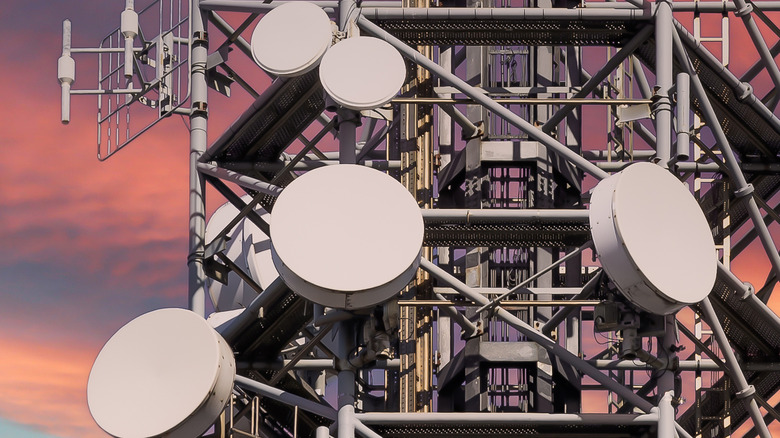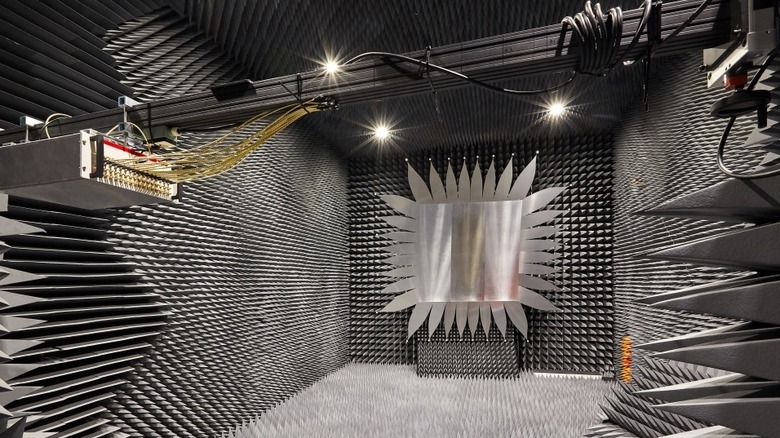Are 5G Signals Bad For Humans? Here's What The Research Says
There has been controversy over whether 5G cell phone signals are harmful for humans ever since the 5G rollout started in 2019. Despite a slew of qualified researchers repeatedly stating that when properly used within current guidelines, devices using 5G technology are safe, rumors and disinformation have still spread. With 5G Advanced on its way, let's look at what the pros say about whether these radio signals can harm humans.
Concerns over 5G signals can be put into three categories, depending on the type of error involved. The first group of concerns relates to a need to better understand the nature of the radio frequency radiation (RFR) that 5G cell phones and base stations put out. The second category centers around a need to better understand that governments regulate exposure to RFR to prevent harm. The third batch encompasses more far-fetched theories that ascribe mythical powers to 5G and the people who manufacture these devices.
Cell phones, towers, and standards
In the U.S., the industry-leading Institute of Electrical and Electronics Engineers (IEEE) has been issuing standards for safety levels concerning human RFR exposure since 1982. Likewise, the International Commission on Non‐Ionizing Radiation Protection (ICNIRP), based in Germany, works with the World Health Organization and the International Labour Organization, among others, to set RFR exposure standards.
The effects of RFR exposure from cell phones at 5G frequencies were already well documented before companies started rolling out 5G service. Most of the frequency bands for 5G were already in use for phone services or were close to the new ones, especially those between 600MHz and 3.5GHz. Along with the IEEE and ICNIRP, government agencies such as the National Cancer Institute (NCI) have been paying attention to cell phone use and possible effects on people. The results of the research done by NCI and others show that the standards developed have been safe and effective. For higher frequencies, IEEE set up a committee for further research, but as these frequencies are used for purposes such as airport scanners, automotive collision avoidance systems, and perimeter surveillance radar, there is already research showing that 5G use is not a problem.
Heat and ionization
If you heat up a cell or damage its DNA, the cell could begin growing unchecked, which can lead to cancer. Most people come in contact with rays that heat up the body's skin cells, namely ultraviolet rays from the sun. At the Earth's surface, ultraviolet rays are not ionizing, but they still can heat a person's skin and cause suntan, sunburn, and over time, skin cancer. Likewise, being very close to very high-power RFR producing machinery can also cause cancer, which is why governments have regulations to prevent that from happening. To damage a cell's DNA to the point that it becomes cancerous requires ionizing rays, such as gamma rays or x-rays. These rays are the highest energy rays on the electromagnetic spectrum, and they penetrate the body. With enough exposure, they cause cancer in inner organs.
Because 5G RFR is not on the same part of the electromagnetic spectrum as these ionizing rays, it is non-ionizing and does not cause cancer. As the government office responsible for radio-related regulation, the FCC sets RFR exposure limits for both occupational and general public environments based largely on guidelines from the National Council on Radiation Protection and Measurements.
Heating in your hand
On a long call or when watching video for a while, the phone can get hot. There is even a phenomenon called phone overheating. Will this cause cancer? No. This type of overheating is not caused by RFR, but by the phone's CPU working harder than usual, especially with video intensive apps. The power output of a cell phone at any frequency is too low to begin heating the skin, even when next to your ear for a long period.
After almost three decades of cell phone use including 5G, National Institutes of Health (NIH) funded studies conclusively show that there has been no increase in the number of brain tumors in the general population compared to decades ago that could be explained by cell phone use. NIH also cites studies from Sweden showing that brain and thyroid cancer rates for people under 20 years of age do not go up with phone use. At the frequencies that a 5G phone operates, the parameters for safe operation are already known.
5G Doesn't Connect With COVID
Along with the issues that come with misunderstanding the nature and effects of RFR, some people have concerns that have no logical ground for belief in the first place. One of these concerns is that the rise of 5G telephony caused or spread the COVID-19 virus. This is not a harmless joke or a conspiracy theory. In April 2020, at least 77 cell towers were vandalized in the UK. One phone company worker was hospitalized after being stabbed. In response, governments began to set up websites to help readers understand that there is no connection between 5G and COVID. Along with research published in professional journals, reporters across the world interviewed microbiologists to help debunk the claims.
The connection between 5G and COVID took a turn later when conspiracy theorists claimed that COVID was actually a cover-up to force mass-injections of 5G-enabled devices under people's skin. This gained enough traction to require media attention against it, including the explanation that such a device would be too large to implant with a COVID vaccine-sized needle.
Weakening immune systems
The 5G-COVID linkage found fertile ground because even before the pandemic began, anti-5G rumor campaigns had started. One of these was that 5G weakened immunity in humans. The Australian Radiation Protection and Nuclear Safety Agency (ARPANSA) in particular addressed this assertion during the COVID pandemic. ARPANSA notes that at power levels much higher than those permitted by the Australian government, the human body's core temperature can rise to the point that it can temporarily affect the immune system. However, at permitted power levels, it does not. In particular, the Australian report points out that research was also done in particular to check for effects on "antigens, antibodies and oxidative stress, have not provided evidence of changes in immune function".
Properly conducted and replicable research shows conclusively that the immune system is not compromised with the use of 5G cell phones. Long-term studies show that government regulations and industry recommendations on the limits to the power levels on cell phones and exposure from antennas on cell towers have worked, and that cancer rates, immune systems, and especially viral infection, have not changed because of 5G or other cell phone systems.





